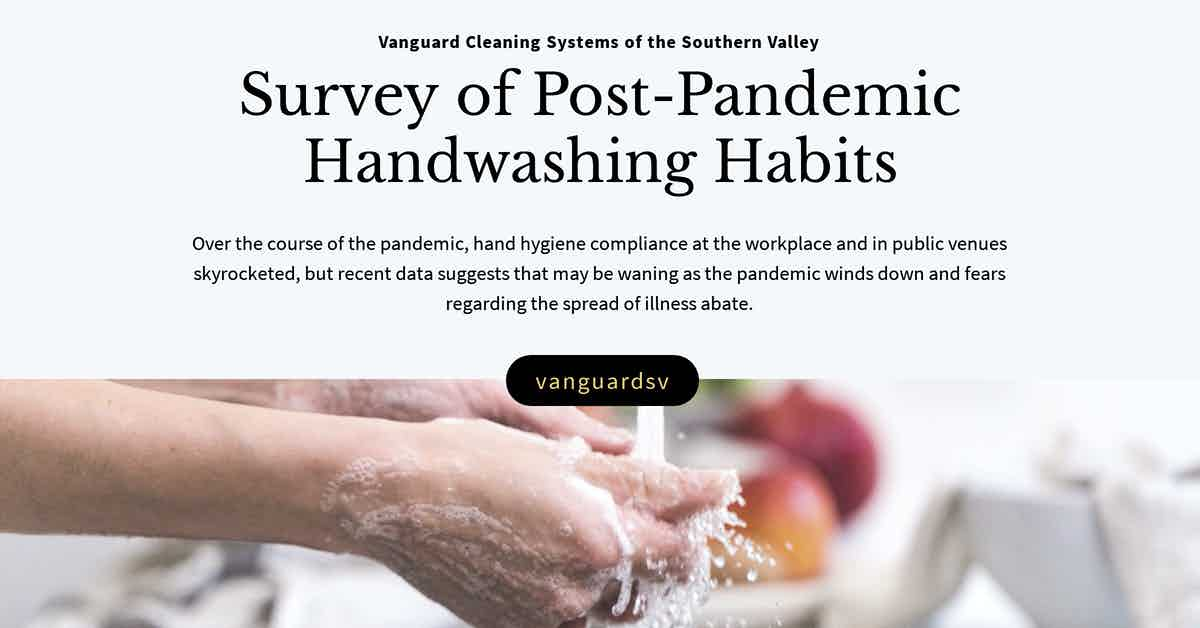Over the course of the pandemic, hand hygiene compliance at the workplace and in public venues skyrocketed, but recent data suggests that may be waning as the pandemic winds down and fears regarding the spread of illness abate.

Post-COVID Changes to Hand Hygiene
During the COVID pandemic, surveys suggested extremely high hand hygiene compliance among respondents across all demographics.
Now, as the pandemic dims, new data indicates hand hygiene compliance and frequencies have declined despite an ongoing concern regarding health and safety in public venues.
According to the results of the survey:
- 23% of respondents stated the pandemic had not changed how often they washed their hands, while 3% said they washed their hands less now than before the pandemic started.
- 11% said they would return to washing their hands about as often as they did prior to the pandemic.
- 29% admitted to only washing their hands for ten or fewer seconds.
- Since the pandemic, half of the respondents stated they have not changed their thoughts on handwashing or think less about it.
- 56% said they clean the surfaces in their workspace more often compared to 30% whose workspace cleaning habits have not changed, and 7% who said they cleaned even less than before.
- 35% said the pandemic had not altered their hand drying habits due to the pandemic, and 3% said they were less likely to dry their hands thoroughly now.
When asked about hygiene behaviors and attitudes that have changed because of the pandemic and which behaviors did they expect to continue post-pandemic:
- 64% cited awareness of their proximity to other people.
- 61% said they paid closer attention to surfaces they touched in public places.
- Paradoxically, 60% stated their handwashing frequency had increased.
- Unsurprisingly, 47% cited increased use of antibacterial products.
- 39% stated they spend more time washing their hands.
- 26% said they spend more time drying their hands.
- 37% stated they had increased how often they sanitize surfaces in their homes, and;
- 10% said the pandemic had not altered their health and hygiene practices.
Despite the wide variation in personal hygiene habits and the apparent decline in certain behaviors, many respondents expressed ongoing levels of unease regarding public safety and hygiene protocols.
- Only 20% of respondents stated they felt confident or very confident in their children's school's hygiene policies and practices.
- 28% said they felt anxious, and 8% stated they were scared when entering a public facility.
- 57% said, in the future, they expected to be wiping down surfaces more in their workplace.
- But only 40% said they would be washing their hands more after moving around the office.
- 17% are somewhat or very dissatisfied with their school or business's hygiene protocols and methods, and;
- 56% stated they were somewhat or very anxious regarding time spent in communal spaces in a facility, such as bathrooms, kitchens, and meeting rooms.
Additional data demonstrated an openly critical stance towards facility managers, school administrators, and business owners regarding their response to facility hygiene protocols and occupant safety.
Source:
Addressing Post-COVID Hygiene Challenges
Addressing the emerging post-COVID challenges will require:
- A single-minded focus to ongoing occupant training regarding the importance of handwashing, drying, and placement awareness in the workplace.
- Routine spot checks and service in restrooms and handwashing stations to ensure cleanliness and supply levels.
- Improvements to environmental sanitation protocols proven to deliver higher cleaning outcomes, such as upgrades to tools, service provider training, checklists, automation, and disinfectant dilution.
- Periodic monitoring of surfaces to ensure environmental cleaning methods are producing positive results and maintaining facility health, and;
- Signage or other communication methods informing occupants of management efforts regarding facility hygiene protocols and ways occupants can protect themselves from infection.
Takeaway
Data shows that gains pertaining to individual hygiene practices accrued during the pandemic have started to slip and will likely continue to do so, which is concerning.
Pre-pandemic data shows an extremely lax attitude toward handwashing, which contributed to the spread of illness and infection in classrooms and offices.
A two-pronged effort of encouraging recommended handwashing frequencies and practices combined with improvements to environmental sanitation will be needed to ensure maximum occupant satisfaction and safety.
For many organizations, investing in custodial service provider training and the tools necessary to remain on top of modern facility health challenges will likely prove cost-prohibitive.
Outsourcing is a proven method for onboarding highly in-demand cleaning and sanitization services and experience for a fraction of the price of maintaining a similar service in-house.
If you would like more information regarding the effectiveness of high-performance infection prevention and control measures, or if you would like to schedule a free, no-obligation on-site assessment of your facility's custodial needs, contact us today for a free quote!
In Bakersfield, CA, call (661) 437-3253
In Fresno, CA, call (559) 206-1059
In Valencia, CA, or Santa Clarita, CA, call (661) 437-3253
In Palmdale, CA or Lancaster, CA, call (661) 371-4756

